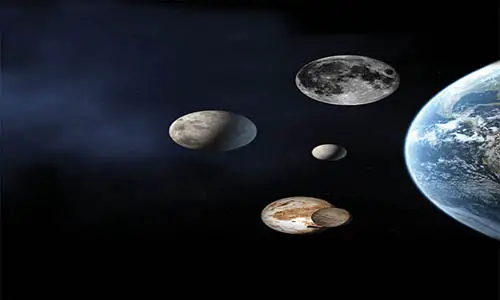According to the International Astronomical Union (IAU), a dwarf planet is a celestial body that orbits around the Sun, has sufficient mass for its self-gravity to overcome rigid body forces so that it assumes a hydrostatic equilibrium (nearly round) shape, is not able to clear its orbital path and is not a satellite, like a moon. The major difference between a planet and a dwarf planet is that a planet has cleared the neighborhood around its orbit whereas a dwarf planet has not. The IAU introduced this new and distinct class of celestial objects, “dwarf planets”, in year 2006. Currently, we have five, officially named, dwarf planets in our solar system: Ceres, Pluto, Haumea, Makemake and Eris. Ceres lies inside the asteroid belt between the orbits of Mass and Jupiter and, the other ones are found beyond the edge of our solar system, or near to, the Kuiper Belt. According to the IAU, there are as many as 10,000 dwarf planets in the solar system.
Here, we have some interesting facts about dwarf planets:
- The largest dwarf planet is considered to be either Pluto or Eris, followed by Makemake, Haumea and Ceres. Ceres is the smallest of the dwarf planets, known till date. The order of the dwarf planets, on the basis of their distance from the Sun, is Ceres, Pluto, Haumea, Makemake and Eris. Eris is the furthest planet from the Sun having a distance of 96.4 Astronomical Units (AU), almost 9 billion miles.
- Pluto was discovered in 1930 and considered to be the ninth planet of the solar system until 2006. In 2006, the planet got a new name, “dwarf planet” by the IAU. It is considered to be the second largest dwarf planet, with Eris, being the most massive of all known dwarf planets.
- Pluto takes about 246.04 Earth years to orbit around the Sun. The planet has five known moons – Charon, Styx, Nix, Kerberos and Hydra.
- Pluto is so small that its size surprised the scientist community when it was first discovered. Even, many moons of the solar system, such as Ganymede, Titan, Callisto, Lo, Europa, Triton and the Earth’s moon, are all larger than Pluto.
- Pluto, being so far away from the Sun, receives sunlight having the same intensity as moonlight on Earth.
- The New Horizons Mission is the first spacecraft that will visit Pluto in July, 2015. It was launched in year 2006.
- Pluto is located within a disc-shaped zone beyond Neptune’s orbit, populated by tiny icy objects and this region is called as, Kuiper belt.
- Ceres is the closest dwarf planet to the Sun and is the only one located in the inner solar system. It is located in the asteroid belt between the orbits of Mars and Jupiter. It is the smallest of all the known dwarf planets having a diameter of only 950 km.
- Ceres was the first, to be considered as an asteroid in the solar system. Giuseppe Piazzi discovered it in early 1801. It was classified as a planet from 1801 until the 1850s, when it was reclassified as an asteroid. It was, then, subsequently, classified as a dwarf planet, in year 2006.
- Ceres accounts for, approximately, one-third of the mass of the entire asteroid belt.
- Ceres orbits around the Sun, taking 4.6 Earth years. The planet is, generally, too dim to be seen with a naked eye.
- The third closest dwarf planet to the Sun is, Haumea, located beyond the orbit of Neptune. It has an elongated shape, making it the least spherical of all known dwarf planets.
- The rotational speed of Haumea, along with its collisional origin, makes this planet the densest of all known dwarf planets.
- The IAU classified Haumea, as “dwarf planet”, on September 17, 2008.
- Haumea is the third brightest object in the Kuiper Belt, after the dwarf planets, Pluto and Makemake.
- Makemake is the second furthest dwarf planet from the Sun. It is the only one, not to have any orbiting satellite (moon).
- Makemake is the largest of the Kuiper Belt objects. The planet can have an extremely low temperature of about -243.2 degree Celsius.
- Eris is the most massive and furthest from the Sun, of all the dwarf planets, discovered till date. It is located beyond the Kuiper Belt in a region, called as the, “scattered disc”.
- Eris has one moon, Dysnomia. Eris is so far away from the Sun that it does not get any sunlight, and it almost freezes, sometimes.











Leave a Reply